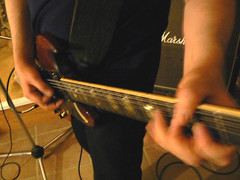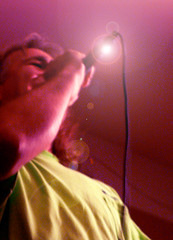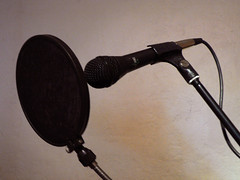Sound and Recording
B. Thomas Cooper
Editor
So your want to play the guitar?
I don't blame you, really. The guitar has been one of the most popular musical instruments for nearly a half a century, and was a major factor in the development of modern music. While players like Duane Eddy and Carl Perkins defined the guitar sound of 1950's pop culture, innovators like Les Paul and Dan Armstrong were pushing the technical limitations. As the quality of the instrument improved its reputation grew exponentially, until no self respecting teenager would be caught without one. Where would Rock' music be today without the advent of the electric guitar?
There are many styles of guitar available for purchase, each with a specific purpose in mind. In this article we shall attempt to cover the basics without boggling the mind.
It al began with the Classical' guitar, an acoustic instrument strung with genuine cat-gut' strings. These days however, most classical players prefer nylon strings, plucked or strummed with the fingers. By the onset of the US civil war, C.F. Martin had ventured into guitar production, manufacturing guitars that had much in common with the violin. Soon the acoustic Dreadnaught' became the guitar of choice.
Unfortunately, the guitar remained a rather personal instrument, not loud enough for an ensemble setting, relegated primarily for use by folk musicians of the era. Around 1945 that all changed with electrical amplification. Within a decade, pop music as we know it would change forever. Songs like "How Much Is That Doggy in the Window" vanished from the airwaves, overwhelmed by the new sound coming from groups like The Ventures. Already it was becoming apparent the electrified version of the guitar was far more versatile that it's acoustic counterpart.
Even now, the guitar continues it's domination over other musical instruments. Guitars are readily available, and relatively easy to learn. Still, and you may quote me on this no two guitars are exactly alike.
When choosing the right guitar, one should never be afraid to ask questions. Although the purchase price will almost certainly be higher at your local guitar dealer, I strongly suggest you begin your search with the experts. Unless you really understand what your needs are, I encourage you to steer away from the pawn shops, as they seldom have your best interest in mind. Whenever possible, take a friend along, preferably one with knowledge of guitars. Don't hesitate to think twice. Take your time and choose your instrument wisely. As your playing improves your taste in guitars will become more discriminating.
Learning to play the guitar can be fun and rewarding, but the wrong guitar will only cause you grief. Ultimately your choice of instrument will be determined by your personal taste and experience. The decision is yours.
SFE-TV
Skate the Razor - CODA
Coming Soon
Spring 2011
Sound Foundation Entertainment - blogment - National Newswire - The Infinite Echo - Sound & Recording - Impeachment Now! - Skate the Razor - Skate the Razor Blog
Friday, October 26, 2007
Wednesday, October 10, 2007
Microphone Placement for Recording Amplified Guitar
Sound and Recording
B. Thomas Cooper
Editor
I recently spent a couple of very short hours advising some rather talented friends of mine on the fine art of properly ‘micing’ a guitar cabinet for recording. Over the course of the evening it occurred to me even the finest seasoned musicians can use a refresher course on common sense every now and then. Myself included.

Fortunately, this group of guys tend to be sensible by nature, a rare commodity for musicians as a whole. Our goal was to record ‘scratch tracks’ of the lead guitar lines for two tunes, and ‘keeper tracks’ for a third. We were recording in Sonar Studio Pro, I believe, an inexpensive, but highly recommended digital recording software.
Scott, the guitarist for the project attended the ‘old school’ of ‘big rock‘, if you catch my drift. We’re talking the classic, early sixties Gibson SG through a Marshall half stack. Of course, the Marshall ‘four twelve’ cabinet needs to be kicked pretty hard, just to get the old girl to bark. (translation: the amplifier needs to go to eleven) This is where our story really begins.

We are set up in a living room, with the computer and various interfaces off to one corner. The Marshall amplifier has been rolled into an adjoining bedroom. The occupant of room, along with his pet Salamander, have been given the boot.
We set the cabinet in the bedroom pointing the speakers toward the right side of the corner, across the length of the bed. We are careful not to point the cabinet directly at the wall, or directly into the corner, as both may produce unwanted response. Sound travels much like water. A pebble in still water will create even concentric ripples, whereas a larger stone is apt to make quite a splash.

At higher decibels, sound also tends to make quite a splash. Especially so, in cramped quarters. One of our greatest concerns will be avoiding the afore mentioned, and truly dreaded ‘square wave’.
The cabinet is about three feet from the edge of the mattress, at perhaps a forty degree angle. It is obvious the old Marshall tube amp will not produce the desired tone at a lower volume, so we don’t even drive down that alley.
Instead we concentrate on controlling the physical properties of sound.
A small collection of throw pillows are arranged on the edge of the mattress to create very subtle baffling. I don’t throw a blanket, or any other object around the cabinet. It normally isn’t necessary.
Next comes the actual ‘micing’ technique. ‘Micing’ is the term used to describe the process of microphone placement. More often than not, microphone placement is a forgotten art form. It is a process often neglected, or simply misunderstood.
There are no hard and fast rules. Use your imagination. That having been said, let’s discuss our situation before progressing any further. Simple guitar tracks, right? Perhaps.
One microphone, or two please? Would you like your sound dry and boxy, or would you prefer a tad of ambience? In other words, do we place the microphone close to the speakers, or far away. How close, or how far away, and why? Does the type of microphone make a difference?
For this situation, I highly recommend an ordinary, medium priced Dynamic microphone. Nothing fancy, mind you. Here’s my reasoning. The polar pattern of most dynamic stage mics responds most favorably within five to fifteen inches of the sound source. Get much closer, and the mic starts to get a little punchy. Back off too far, and the mic doesn’t reproduce transients. Transients are those are the little things, the stuff of which your sound is made of. We really don’t want to lose them in transmission.
The cabinet we are ‘micing’ contains four standard twelve inch Celestion speakers. Our goal is to place the mic close enough to catch the little things but far enough so as not to do the freak. Here’s a few quick don’ts. Don’t ever drape the mic over the front of the cabinet. Sound doesn’t work that way. Don’t ever put the microphone directly against the grill cloth or speaker.
Don’t ‘mic’ the center of a four twelve cabinet, and don’t point the microphone directly at the center of the speaker. That round looking thing in the center of the speaker, well, that’s a dust cover. It does not reproduce sound. Whenever possible, aim the microphone at an angle parallel to the paper of the speaker cone.
We set the mic about s foot or so from the cabinet, and after a quick listen, we moved the microphone forward perhaps two inches. It was all very simple, and very productive. Very little time was squandered twittering knobs and wiggling stands.
The session was a success on multiple fronts. Scott got to keep his tone, and Jon, the producer, got to keep his sanity. It was a pleasant evening for all. The moral to this story? Think about what you are trying to accomplish, take your time, keep it simple, and by all means, enjoy the process.
B. Thomas Cooper
Editor
I recently spent a couple of very short hours advising some rather talented friends of mine on the fine art of properly ‘micing’ a guitar cabinet for recording. Over the course of the evening it occurred to me even the finest seasoned musicians can use a refresher course on common sense every now and then. Myself included.

Fortunately, this group of guys tend to be sensible by nature, a rare commodity for musicians as a whole. Our goal was to record ‘scratch tracks’ of the lead guitar lines for two tunes, and ‘keeper tracks’ for a third. We were recording in Sonar Studio Pro, I believe, an inexpensive, but highly recommended digital recording software.
Scott, the guitarist for the project attended the ‘old school’ of ‘big rock‘, if you catch my drift. We’re talking the classic, early sixties Gibson SG through a Marshall half stack. Of course, the Marshall ‘four twelve’ cabinet needs to be kicked pretty hard, just to get the old girl to bark. (translation: the amplifier needs to go to eleven) This is where our story really begins.

We are set up in a living room, with the computer and various interfaces off to one corner. The Marshall amplifier has been rolled into an adjoining bedroom. The occupant of room, along with his pet Salamander, have been given the boot.
We set the cabinet in the bedroom pointing the speakers toward the right side of the corner, across the length of the bed. We are careful not to point the cabinet directly at the wall, or directly into the corner, as both may produce unwanted response. Sound travels much like water. A pebble in still water will create even concentric ripples, whereas a larger stone is apt to make quite a splash.

At higher decibels, sound also tends to make quite a splash. Especially so, in cramped quarters. One of our greatest concerns will be avoiding the afore mentioned, and truly dreaded ‘square wave’.
The cabinet is about three feet from the edge of the mattress, at perhaps a forty degree angle. It is obvious the old Marshall tube amp will not produce the desired tone at a lower volume, so we don’t even drive down that alley.
Instead we concentrate on controlling the physical properties of sound.
A small collection of throw pillows are arranged on the edge of the mattress to create very subtle baffling. I don’t throw a blanket, or any other object around the cabinet. It normally isn’t necessary.
Next comes the actual ‘micing’ technique. ‘Micing’ is the term used to describe the process of microphone placement. More often than not, microphone placement is a forgotten art form. It is a process often neglected, or simply misunderstood.
There are no hard and fast rules. Use your imagination. That having been said, let’s discuss our situation before progressing any further. Simple guitar tracks, right? Perhaps.
One microphone, or two please? Would you like your sound dry and boxy, or would you prefer a tad of ambience? In other words, do we place the microphone close to the speakers, or far away. How close, or how far away, and why? Does the type of microphone make a difference?
For this situation, I highly recommend an ordinary, medium priced Dynamic microphone. Nothing fancy, mind you. Here’s my reasoning. The polar pattern of most dynamic stage mics responds most favorably within five to fifteen inches of the sound source. Get much closer, and the mic starts to get a little punchy. Back off too far, and the mic doesn’t reproduce transients. Transients are those are the little things, the stuff of which your sound is made of. We really don’t want to lose them in transmission.
The cabinet we are ‘micing’ contains four standard twelve inch Celestion speakers. Our goal is to place the mic close enough to catch the little things but far enough so as not to do the freak. Here’s a few quick don’ts. Don’t ever drape the mic over the front of the cabinet. Sound doesn’t work that way. Don’t ever put the microphone directly against the grill cloth or speaker.
Don’t ‘mic’ the center of a four twelve cabinet, and don’t point the microphone directly at the center of the speaker. That round looking thing in the center of the speaker, well, that’s a dust cover. It does not reproduce sound. Whenever possible, aim the microphone at an angle parallel to the paper of the speaker cone.
We set the mic about s foot or so from the cabinet, and after a quick listen, we moved the microphone forward perhaps two inches. It was all very simple, and very productive. Very little time was squandered twittering knobs and wiggling stands.
The session was a success on multiple fronts. Scott got to keep his tone, and Jon, the producer, got to keep his sanity. It was a pleasant evening for all. The moral to this story? Think about what you are trying to accomplish, take your time, keep it simple, and by all means, enjoy the process.
Monday, October 1, 2007
More Tips For Recording Vocals
Sound and Recording
B. Thomas Cooper
Editor
When it comes to recording vocals, misconceptions abound. So many wonderful singers, so little dependable information. We are all instantly capable of recognizing a strong vocal performance, but what goes into capturing that performance usually isn't so obvious.
It all starts with a good singer and a good song. From there, choose a reliable microphone. Many engineers prefer using large diaphragm condenser microphones, but I have no preference. After thirty years of intensive studio experience I have learned to rely on the vocalist, not the microphone. While working as a staff producer at the world famous Power Station Studios, I had at my disposal, nearly every mic imaginable. One quickly learns that not every vocal should be captured with an expensive ribbon mic. Think hard about what it is you're trying to accomplish. Feel free to experiment.

Remember, good microphone technique and proper singing habits will profoundly effect your vocal performance. A mic can only capture what you produce. Once the performance has been captured, it can be enhanced through various means, including reverb, compression, etc. but all the reverb in the world will not drown out a bad performance.
Singers tend to be a finicky lot, a fact I can personally attest to. Still, no two vocalists are alike. Do whatever it takes to make the singer comfortable and confident. A good headphone mix is crucial. If you can't hear what your doing, you stand little chance of doing it well. I can honestly say the Power Station had the best headphone systems I have ever experienced. It is little wonder to me why the studio produced so many hit records.
From here, things get somewhat slippery. A producer like Terry Date will not approach a vocal for the Deftones in the same manner Jim Steinman might approach a Meat Loaf recording. Even at the highest levels of the industry, approach can be radically different.
Unless all indications suggest to the contrary, go with the flow. In other words, don't rock the boat. Learn all you can about recording, and keep an open mind. A vocal track can make or break an otherwise average recording. It is our goal to recognize the difference.
B. Thomas Cooper
Editor
When it comes to recording vocals, misconceptions abound. So many wonderful singers, so little dependable information. We are all instantly capable of recognizing a strong vocal performance, but what goes into capturing that performance usually isn't so obvious.
It all starts with a good singer and a good song. From there, choose a reliable microphone. Many engineers prefer using large diaphragm condenser microphones, but I have no preference. After thirty years of intensive studio experience I have learned to rely on the vocalist, not the microphone. While working as a staff producer at the world famous Power Station Studios, I had at my disposal, nearly every mic imaginable. One quickly learns that not every vocal should be captured with an expensive ribbon mic. Think hard about what it is you're trying to accomplish. Feel free to experiment.

Remember, good microphone technique and proper singing habits will profoundly effect your vocal performance. A mic can only capture what you produce. Once the performance has been captured, it can be enhanced through various means, including reverb, compression, etc. but all the reverb in the world will not drown out a bad performance.
Singers tend to be a finicky lot, a fact I can personally attest to. Still, no two vocalists are alike. Do whatever it takes to make the singer comfortable and confident. A good headphone mix is crucial. If you can't hear what your doing, you stand little chance of doing it well. I can honestly say the Power Station had the best headphone systems I have ever experienced. It is little wonder to me why the studio produced so many hit records.
From here, things get somewhat slippery. A producer like Terry Date will not approach a vocal for the Deftones in the same manner Jim Steinman might approach a Meat Loaf recording. Even at the highest levels of the industry, approach can be radically different.
Unless all indications suggest to the contrary, go with the flow. In other words, don't rock the boat. Learn all you can about recording, and keep an open mind. A vocal track can make or break an otherwise average recording. It is our goal to recognize the difference.
Subscribe to:
Posts (Atom)







